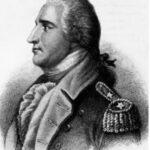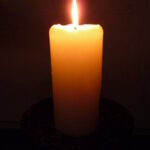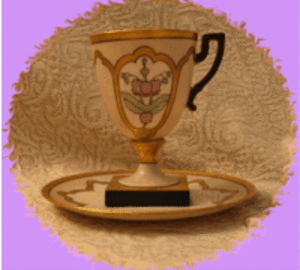Matthew Arnold suggests that, “The pursuit of perfection, is the pursuit of sweetness and light.” In many ways, this is exactly what the characters of The Glass Menagerie are looking for in the play- perfection. They look for it in their future, as they search for a way to find security and hope. They find glimmers of hope throughout the story, yet each time it is extinguished like the candles at the end of the play. In Tennessee Williams’ play The Glass Menagerie, light serves as a symbol of hope, which is evident in the descriptive stage directions, as well as through the image of rainbows constantly brought into the play, and in specific images of light such as a lamp, or candles.
Williams has a way of using very detailed stage directions to not only tell the characters what to do on stage, but also to give a sense of the character’s feelings at certain points in the play. In the sixth scene, as Amanda and Laura are preparing for Jim’s arrival, the stage directions describe Laura as being “like a piece of translucent glass touched by light, given a momentary radiance, not actual, not lasting” (1748). In this description, Williams uses the idea of light to describe Laura’s character and disposition at this moment. These are not actual instructions for the light technicians, but rather a description for the actor playing Laura. When saying that she has been “given a momentary radiance,” Williams depicts the temporary hope that comes from the prospect of a suitor for Laura. It is not a lasting radiance, which foreshadows the end of the play where that hope will dissolve. In the next scene, when Jim and Laura are talking, Williams again uses the stage directions to describe Laura’s sense of hope in terms of light. This occurs at the moment when Laura has just found out that Jim is not engaged to his high school girlfriend Emily. The directions say that Jim smiles at Laura “with a warmth and charm which lights her inwardly” (1762). Then, when she finds out just a few minutes later that Jim is engaged to a girl named Betty, the stage directions describe how the “holy candles on the altar of Laura’s face have been snuffled out” (1768). These descriptions of Laura’s inward light show the hope she has at the idea that Jim is available, and then how her hope is crushed as she realizes that he is not.
By the time this occurs, the reader or audience almost expects it, and this is mainly because the lighting of the play does not give the feeling that it is a positive play with a beautiful happy ending. From the very beginning, the stage directions, as well as the dialogue, directly tell us that the play is dimly lighted (1723). Then in the beginning of the final scene, all the lights go out (because Tom has not paid the electric bill), and the only lighting left on stage is candlelight. This extinguishing of the lights foreshadows the extinguishing of the family’s hopes that is to come at the end of the play, as Jim announces that he is engaged. Through the use of light in the play, it is clear that the play does not leave the characters looking towards the bright hope of their future, but rather realizing their dim reality.
In a slight spin-off from the symbol of light, Williams also uses the image of a rainbow to portray the concept of promise in the play. Biblically, the rainbow is a symbol of promise, as it appeared after the flood of Noah showing God’s promise never again to destroy the earth in such a way. As George Ehrenhaft comments, a rainbow may be a symbol of promise, “but when you get close it vanishes. It’s an illusion, a false promise…” (11). The symbol of the rainbow in The Glass Menagerie functions to show the illusion of hope, for just as the characters get within reach of attaining what they hope for, it always seems to vanish. Tom talks about rainbows at the beginning of the fifth scene, just before he announces to Amanda that he has invited Jim over. He describes the dance hall next door to their apartment, and the “glass sphere that hung from the ceiling. It would slowly turn about and filter the dusk with delicate rainbow colors.” He continues on in the monologue to describe the scene outside the dance hall and the concept of adventure and change in the world, but ends commenting that there they have only “hot swing music and liquor, dance halls, bars, and movies, and sex that hung in the gloom like a chandelier and flooded the world with brief, deceptive rainbows.” Then the scene progresses and the family is flooded with a brief, deceptive rainbow, with the prospect of Jim’s visit. Jim’s visit is like a rainbow because, from far away, it carries the hope of a promise for something better for Laura, and yet, once up close, that hope disappears as Jim was not an available gentleman as he seemed to be.
Laura’s glass animals are also used to portray this illusion of hope. In the seventh scene, when Laura is talking to Jim, she shows Jim the glass unicorn and says, “Hold him over the light, he loves the light! You see how the light shines through him?” (1764). Shops that sell such glass animals often display them in a beautifully lighted window case to take advantage of what occurs when light shines through the little glass figures. They give off little rainbow rays, making it appear as if the glass itself were rainbow colored. As Jim holds the unicorn and comments “It sure does shine,” one can imagine the rainbow ray that the little unicorn gives off. This unicorn comes to symbolize the mystical beauty of love that Laura has been waiting for. This love “comes to her, however fleetingly, in the person of Jim” (Cardullo 3). Yet, like the rainbow light of the glass unicorn, this hope of love is just an illusion.
Tom mentions rainbows again in his final monologue. As he describes how he leaves Amanda and Laura, he muses, “I pass the lighted window of a shop where perfume is sold. The window is filled with pieces of colored glass, tiny transparent bottles in delicate colors, like bits of a shattered rainbow.” A shattered rainbow is such an appropriate image for this final monologue as Tom’s desertion of the family seems to feel like the final shattering of hope for the Wingfield women. While the rainbow is only an illusion of promise, Tom’s leaving represents the fact that there is no longer even that illusion of hope for the future. All hope is gone, just like Tom.
For Amanda, her symbol of hope for the future is a lamp. In the fifth scene, when Tom announces that Jim is coming for dinner, Amanda excitedly tells that she has been making payments on a floor lamp that she will have sent out for the occasion (1744). By the sixth scene, before Jim is to arrive, the new lamp, “with its rose silk shade” is placed in the living room (1747), symbolizing the hope of Jim’s return. This hope turns out to be pointless, which Amanda recognizes towards the end show, noting that “all the expense” has basically been for nothing, and the first expense she lists is “the new floor lamp” (1771). The new lamp is a symbol of hope to Amanda, and its presence in her living room when Jim arrives makes her feel that there is hope for Laura and for their future. Like all other hope in the play, it too is for nothing.
In the end of Tom’s final monologue, the symbol of hope turns to Laura’s candles, which were brought by Jim into the scene, a symbol of hope for Laura, that Jim may be a chance at love. Tom speaks as if to Laura, “I reach for a cigarette, I cross the street, I run into the movies or a bar, I buy a drink, I speak to the nearest stranger- anything that can blow your candles out!” (1772). Tom sees these candles as Laura’s hope, which as he runs away from the family he cannot seem to get out of his mind. He does not want the family to suffer in the illusion of hope any further. He sees the world as a dark and stormy place, saying “For nowadays the world is lit by lightning! Blow out your candles, Laura- and so goodbye…” (1772). Laura does then blow out the candles, the final light on stage, leaving the stage dark. This symbolizes not only a goodbye to Tom, but also saying goodbye to the hope of love and a brighter future. In an essay titled “Williams’ The Glass Menagerie,” Bert Cardullo comments that, when Laura blows the candles out, “The implication is that no gentleman caller will ever enter her life again” (11), which, to Amanda and Laura, truly means that hope will never enter their lives again.
It seems fitting that the play ends with a completely dark stage, as the future looks dark for the Wingfield family. As far as Amanda sees it, without a man to take care of them they are doomed. Laura will never be able to work; Tom is gone, and it seems that no “gentleman caller” will ever enter the women’s lives again. Cardullo notes that, “The character of Tom is based in part on Tennessee Williams himself, and Laura is modeled after Williams’ beloved sister, Rose” (12). Because the play is autobiographical, it has the feeling that Williams is grasping at something regretful in his own past, implying that hope never did come to this family. When the lights go out at the end of the play, it is dark for good.
Works Cited
Williams, Tennessee. The Glass Menagerie. Ed. Robert DiYanni. Literature: Reading Fiction, Poetry, and Drama. 6th ed. Boston: McGraw-Hill, 2007. 1718-1773.
Cardullo, Bert. “Williams’s The Glass Menagerie.” The Explicator. 22 March 1997. . paragraphs 1-12.
Ehrenhaft, George. “The Glass Menagerie and A Streetcar Named Desire.” Barron’s Booknotes. 01 August 2004.





